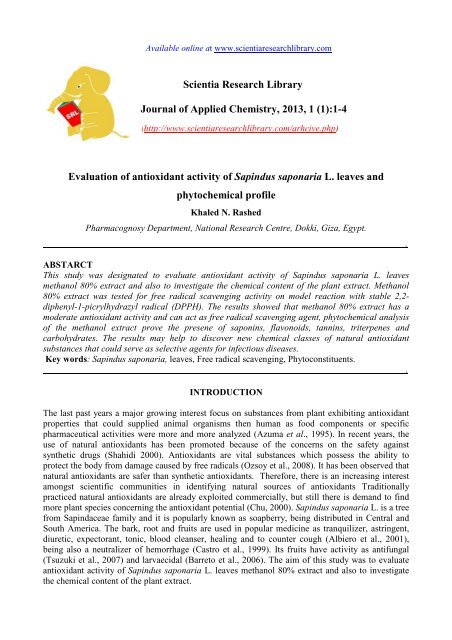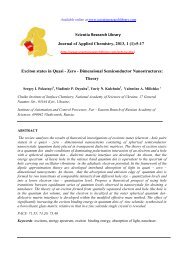p18fktcovk1omc1fhk1otmmle17bc4.pdf
Create successful ePaper yourself
Turn your PDF publications into a flip-book with our unique Google optimized e-Paper software.
Available online at www.scientiaresearchlibrary.com<br />
Scientia Research Library<br />
Journal of Applied Chemistry, 2013, 1 (1):1-4<br />
(http://www.scientiaresearchlibrary.com/arhcive.php)<br />
Evaluation of antioxidant activity of Sapindus saponaria L. leaves and<br />
phytochemical profile<br />
Khaled N. Rashed<br />
Pharmacognosy Department, National Research Centre, Dokki, Giza, Egypt.<br />
.<br />
ABSTARCT<br />
This study was designated to evaluate antioxidant activity of Sapindus saponaria L. leaves<br />
methanol 80% extract and also to investigate the chemical content of the plant extract. Methanol<br />
80% extract was tested for free radical scavenging activity on model reaction with stable 2,2-<br />
diphenyl-1-picrylhydrazyl radical (DPPH). The results showed that methanol 80% extract has a<br />
moderate antioxidant activity and can act as free radical scavenging agent, phytochemical analysis<br />
of the methanol extract prove the presene of saponins, flavonoids, tannins, triterpenes and<br />
carbohydrates. The results may help to discover new chemical classes of natural antioxidant<br />
substances that could serve as selective agents for infectious diseases.<br />
Key words: Sapindus saponaria, leaves, Free radical scavenging, Phytoconstituents.<br />
.<br />
INTRODUCTION<br />
The last past years a major growing interest focus on substances from plant exhibiting antioxidant<br />
properties that could supplied animal organisms then human as food components or specific<br />
pharmaceutical activities were more and more analyzed (Azuma et al., 1995). In recent years, the<br />
use of natural antioxidants has been promoted because of the concerns on the safety against<br />
synthetic drugs (Shahidi 2000). Antioxidants are vital substances which possess the ability to<br />
protect the body from damage caused by free radicals (Ozsoy et al., 2008). It has been observed that<br />
natural antioxidants are safer than synthetic antioxidants. Therefore, there is an increasing interest<br />
amongst scientific communities in identifying natural sources of antioxidants Traditionally<br />
practiced natural antioxidants are already exploited commercially, but still there is demand to find<br />
more plant species concerning the antioxidant potential (Chu, 2000). Sapindus saponaria L. is a tree<br />
from Sapindaceae family and it is popularly known as soapberry, being distributed in Central and<br />
South America. The bark, root and fruits are used in popular medicine as tranquilizer, astringent,<br />
diuretic, expectorant, tonic, blood cleanser, healing and to counter cough (Albiero et al., 2001),<br />
being also a neutralizer of hemorrhage (Castro et al., 1999). Its fruits have activity as antifungal<br />
(Tsuzuki et al., 2007) and larvaecidal (Barreto et al., 2006). The aim of this study was to evaluate<br />
antioxidant activity of Sapindus saponaria L. leaves methanol 80% extract and also to investigate<br />
the chemical content of the plant extract.
Khaled N. Rashed et al Journal of Applied Chemistry, 2013, 1(1):1:4<br />
______________________________________________________________________________<br />
MATERIALS AND METHODS<br />
Plant identification and collection<br />
Sapindus saponaria L. leaves were collected from Al-Zohiriya garden, Giza, Egypt in May 2012.<br />
The plant was identified by Dr. Mohammed El-Gebaly, Department of Botany, National Research<br />
Centre (NRC) and by Mrs. Tereez Labib Consultant of Plant Taxonomy at the Ministry of<br />
Agriculture and director of Orman botanical garden, Giza, Egypt. A voucher specimen was<br />
deposited in the herbarium of Al-Zohiriya garden, Giza, Egypt.<br />
Preparation of the plant extract<br />
Air-dried powder of Sapindus saponaria leaves (500 g) was extracted with methanol 80% several<br />
times at room temperature until exhaustion by maceration method. The extract was concentrated<br />
under reduced pressure to give 28 g of the crude extract and the extract was subjected to different<br />
phytochemical tests according to that described by Yadav and Agarwala (2011).<br />
DPPH assay<br />
The scavenging reaction between (DPPH•) and an antioxidant (H-A) can be written as: DPPH • + H<br />
- A→ DPPH - H + A•.(Anna et al., 2012). Antioxidants react with DPPH•, which is a stable free<br />
radical and is reduced to the DPPH-H and as consequence the absorbance decreased from the<br />
DPPH• radical to the DPPH-H form. The degree of discoloration indicates the scavenging potential<br />
of the antioxidant extract in terms of hydrogen donating ability. DPPH radical scavenging activity<br />
from the plant extract was measured by taking 100µg/ml of extract, 900µl of acetate buffer and 3 ml<br />
freshly prepared 100µM DPPH solution in methanol. Reagent blank was 1 ml buffer and 3 ml<br />
DPPH solution. The absorbance was measured after 90 min of incubation in dark at 517 nm. DPPH<br />
radical scavenging activity (%) was determined by following equation:<br />
DPPH radical scavenging: Activity (%) = A b -A s /A b x 100.<br />
(A s - absorbance of the test sample, A b - absorbance control reaction)<br />
Table 1. Antioxidant activity of S. saponaria leaves methanol extract<br />
Concentration<br />
(%)<br />
DPPH free radical<br />
scavenging effect (%)<br />
Green tea extract 1% 96.41%<br />
S. saponaria leaves methanol<br />
extract<br />
0.1% 50.97%<br />
Table 2. Preliminary phytochemical analysis of S. saponaria leaves<br />
Chemical Constituents<br />
methanol extract<br />
Carbohydrates and/or glycosides +<br />
Tannins<br />
a. Condensed tannins<br />
b. Hydrolysable tannins<br />
Alkaloids and/or nitrogenous bases -<br />
Flavonoids +<br />
Sterols and/or triterpenes +<br />
Saponins +<br />
Coumarins -<br />
(+ ) denotes the presence of the constituents, (-) denotes the absence of the constituents<br />
2<br />
+<br />
+
Khaled N. Rashed et al Journal of Applied Chemistry, 2013, 1(1):1:4<br />
______________________________________________________________________________<br />
RESULT AND DISSCUSION<br />
The results of antioxidant activity of S. saponaria leaves methanol extract is shown in table 1, and<br />
the phytoconstituents of the plant extract is shown in table 2. These results prove that the methanol<br />
extract of S. saponaria leaves has a moderate antioxidant activity with comparison with green tea<br />
extract as a standard and this activity is may be due to the presence of different phytochemicals as<br />
flavonoids which have a wide range of biological activities and from these activities are antioxidant<br />
effect, (Giovanni et al., 2012). The highest level of radical scavenging properties at low<br />
concentrations of flavonoids exhibits quercetin and in the following order luteolin, rhamnetin,<br />
isorhamnetin and apigenin. The strong antioxidant potential could allow to administer flavonoids<br />
for prevention of numerous free radical based diseases (Giovanni et al., 2012). Triterpenes are a<br />
class of natural products present in all organisms, especially in plants. The triterpene acids exhibit<br />
unique and important biological and pharmacological activities, including antioxidant antiinflammatory,<br />
antimicrobial, antiviral, cytotoxic and cardiovascular effects (Maria et al., 2012).<br />
CONCLUSION<br />
The presented results indicate a moderate antioxidant potential of S. saponaria leaves methanol<br />
extract and this activity is due the presence of different phytoconstituents as flavonoids and<br />
triterpenes.<br />
REFERENCES<br />
[1] Albiero ALM, Bacchi EM, Mourao KSM. (2001). Caracterizacao anatomica das folhas, frutos e<br />
sementes de Sapindus saponaria L. (Sapindaceae). Acta Science 23, 549-560.<br />
[2]Anna G-G, Marlena D-M, Irena M. (2012). DPPH Radical Scavenging Activity And Phenolic<br />
Compound Content In Different Leaf Extracts From Selected Blackberry Species.Acta Biologica<br />
Cracoviensia Series Botanica 54 (2): 32–38.<br />
[3]Azuma Y, Nakawo KM, Jiankany H, Watanabe O .1995. Metting induced relocation of ions in<br />
glacier and in a seasonal snow-pack. IAHS Predictions in Ungauged Basins 223, 287-287.<br />
[4]Barreto CF, Cavasin GM, Silva HHG, Silva IG. (2006). Estudo das alteracoes morfohistologicas<br />
em larvas de Aedes aegypti (Diptera, culicidae) submetidas ao extrato bruto etanolico<br />
de Sapindus saponaria Lin (SAPINDACEAE). Rev Patol Trop 35, 37-57.<br />
[4]Castro O, Guitierrez JM, Barrios M, Castre I, Romero UE. (1999). Neutralizacion del efecto<br />
hemorragico inducido por veneno de Bothropsasper (Serpentes:Viperidae) por extractos de plantas<br />
tropicales. Rev Biol Trop 47, 605-616.<br />
[5]Chu Y (2000). Flavonoid content of several vegetables and their antioxidant activi-ty. Journal of<br />
Science, food and Agriculture 80, 561-566.<br />
[6]Giovanni Agatia, Elisa Azzarellob, Susanna Pollastri b, Massimiliano Tattini . Flavonoids as<br />
antioxidants in plants: Location and functional significance Plant Science (2012) 196, 67– 76.<br />
[7]Ozsoy N, Can A, Yanardag, R, Akev N (2008). Antioxidant activity of Smilax excelsa leaf<br />
extracts. Food Chemistry 110, 571 - 583.<br />
3
Khaled N. Rashed et al Journal of Applied Chemistry, 2013, 1(1):1:4<br />
______________________________________________________________________________<br />
[8]Maria de L. e Silva, Juceni P. David, Lidércia C. R. C. Silva, Rauldenis A. F. Santos, Jorge M.<br />
David , Luciano S. Lima 3, Pedro S. Reis and Renato Fontana. Bioactive Oleanane, Lupane and<br />
Ursane Triterpene Acid Derivatives Molecules 2012, 17, 12197-12205.<br />
[9]Shahidi, F., Wanasundara, P.K.J.P.D. 1992. Phenolic antioxidants: Critical Reviews in Food<br />
Science and Nutrition 32: 67-103.<br />
[10]Tsuzuki JK, Svidzinski TIE, Shinobu CS, Silva LFA, Rodrigues-Filho E, Cortez DAG, Ferreira<br />
ICP. (2007). Antifungal activity of the extracts and saponins from Sapindus sopanaria L. An Acad<br />
Bras Cienc 79, 577-583.<br />
[11]Yadav RNS, Agarwala M. (2011). Phytochemical analysis of some medicinal plants. Journal of<br />
Phytology 3(12): 10-14.<br />
4



